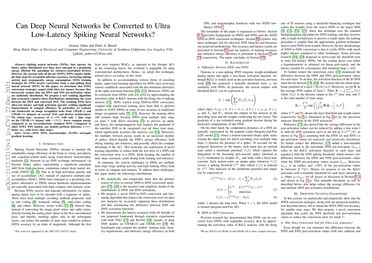Can Deep Neural Networks be Converted to Ultra Low-Latency Spiking Neural Networks?
Spiking neural networks (SNNs), that operate via binary spikes distributed over time, have emerged as a promising energy efficient ML paradigm for resource-constrained devices. However, the current state-of-the-art (SOTA) SNNs require multiple time steps for acceptable inference accuracy, increasing spiking activity and, consequently, energy consumption. SOTA training strategies for SNNs involve conversion from a non-spiking deep neural network (DNN). In this paper, we determine that SOTA conversion strategies cannot yield ultra low latency because they incorrectly assume that the DNN and SNN pre-activation values are uniformly distributed. We propose a new training algorithm that accurately captures these distributions, minimizing the error between the DNN and converted SNN. The resulting SNNs have ultra low latency and high activation sparsity, yielding significant improvements in compute efficiency. In particular, we evaluate our framework on image recognition tasks from CIFAR-10 and CIFAR-100 datasets on several VGG and ResNet architectures. We obtain top-1 accuracy of 64.19% with only 2 time steps on the CIFAR-100 dataset with ~159.2x lower compute energy compared to an iso-architecture standard DNN. Compared to other SOTA SNN models, our models perform inference 2.5-8x faster (i.e., with fewer time steps).
PDF Abstract
 CIFAR-10
CIFAR-10
 CIFAR-100
CIFAR-100